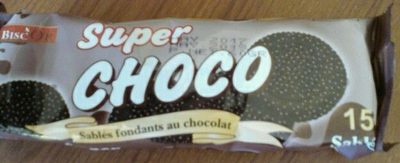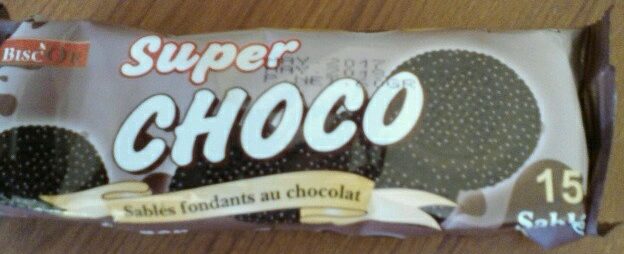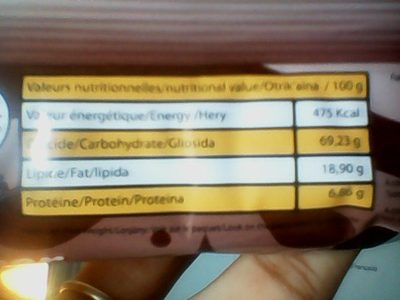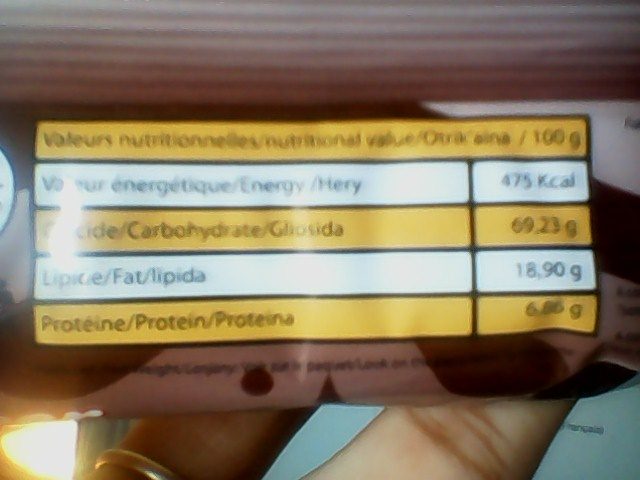Aidez-nous à faire de la transparence alimentaire la norme !
En tant qu'organisation à but non lucratif, nous dépendons de vos dons pour continuer à informer les consommateurs du monde entier sur ce qu'ils mangent.
La révolution alimentaire commence avec vous !
SUPER CHOCO - BISC'OR - 60 g
SUPER CHOCO - BISC'OR - 60 g
La page de ce produit n'est pas complète. Vous pouvez aider à la compléter en l'éditant et en ajoutant plus de données à partir des photos que nous avons, ou en prenant plus de photos à l'aide de l'application pour Android ou iPhone / iPad. Merci!
×
Code-barres: 6161105491637 (EAN / EAN-13)
Dénomination générique : BISCUIT AU CHOCOLAT
Quantité : 60 g
Conditionnement : Plastique
Marques : BISC'OR
Catégories : Snacks, Snacks sucrés, Biscuits et gâteaux, Biscuits, Biscuits au chocolat, Biscuits au chocolat noir
Origine des ingrédients : Madagascar
Lieux de fabrication ou de transformation : MADAGASCAR
Magasins : SHOPRITE
Pays de vente : Madagascar
Correspondance avec vos préférences
Santé
Ingrédients
-
14 ingrédients
Farine de blé, sucre, matière graisse végétale, Poudre de cacao, poudre à lever (bicarbonate d'amonium E503_bicarbonate de sodium E500), metabisulfite de sodium E223, sel, émulsifiant : lecithine de soja (E5222),préparation aromatique, colorant alimentaire (E 150d)Allergènes : GlutenTraces : Gluten
Transformation des aliments
-
Aliments ultra-transformés
Éléments qui indiquent que le produit est dans le groupe 4 - Produits alimentaires et boissons ultra-transformés :
- Additif : E150d - Caramel au sulfite d'ammonium
- Additif : E322 - Lécithines
- Ingrédient : Colorant
- Ingrédient : Émulsifiant
- Ingrédient : Arôme
Les produits alimentaires sont classés en 4 groupes selon leur degré de transformation :
- Aliments non transformés ou minimalement transformés
- Ingrédients culinaires transformés
- Aliments transformés
- Aliments ultra-transformés
La détermination du groupe est basée sur la catégorie du produit et sur les ingrédients qu'il contient.
Additifs
-
E223 - Disulfite de sodium
Métabisulfite de sodium : Le métabisulfite de sodium ou pyrosulfite de sodium est un désinfectant, antioxydant et conservateur alimentaire jaunâtre. L'IUPAC nomme l'ion S2O52- l'ion disulfite. Il ne doit pas être confondu avec l'ion bisulfite HSO3- qui est l'ancien nom de hydrogénosulfite.Source : Wikipedia
-
E322 - Lécithines
Les lécithines font partis des additifs les plus utilisés dans l'industrie agroalimentaire, puisqu'ils sont présents dans 17 % des produits alimentaires selon l'Anses. Ils ne présentent pas de risques connus pour la santé.
-
E322i - Lécithine
Les lécithines font partis des additifs les plus utilisés dans l'industrie agroalimentaire, puisqu'ils sont présents dans 17 % des produits alimentaires selon l'Anses. Ils ne présentent pas de risques connus pour la santé.
Analyse des ingrédients
-
Pourrait contenir de l'huile de palme
Ingrédients pouvant contenir de l'huile de palme : Matière grasse végétale
-
Caractère végétalien inconnu
Ingrédients non reconnus : Bicarbonate-d-amonium-e503-bicarbonate-de-sodium-e500, E5222Certains ingrédients n'ont pas été identifiés.
Nous avons besoin de votre aide !
Vous pouvez nous aider à reconnaître d'autres ingrédients et à mieux analyser la liste des ingrédients pour ce produit et d'autres en :
- Modifiez la page de ce produit pour corriger les fautes d'orthographe dans la liste des ingrédients, pour supprimer des ingrédients dans d'autres langues ou pour supprimer des phrases qui ne correspondent pas aux ingrédients.
- Ajoutez de nouvelles entrées, synonymes ou traductions à nos listes multilingues d'ingrédients, de méthodes de traitement des ingrédients, et de labels.
Rejoignez le canal #ingredients dans notre espace de discussion Slack et apprenez-en plus sur l'analyse des ingrédients sur notre wiki, si vous désirez nous aider. Merci !
-
Caractère végétarien inconnu
Ingrédients non reconnus : Bicarbonate-d-amonium-e503-bicarbonate-de-sodium-e500, E5222Certains ingrédients n'ont pas été identifiés.
Nous avons besoin de votre aide !
Vous pouvez nous aider à reconnaître d'autres ingrédients et à mieux analyser la liste des ingrédients pour ce produit et d'autres en :
- Modifiez la page de ce produit pour corriger les fautes d'orthographe dans la liste des ingrédients, pour supprimer des ingrédients dans d'autres langues ou pour supprimer des phrases qui ne correspondent pas aux ingrédients.
- Ajoutez de nouvelles entrées, synonymes ou traductions à nos listes multilingues d'ingrédients, de méthodes de traitement des ingrédients, et de labels.
Rejoignez le canal #ingredients dans notre espace de discussion Slack et apprenez-en plus sur l'analyse des ingrédients sur notre wiki, si vous désirez nous aider. Merci !
-
Détail de l'analyse des ingrédients
Nous avons besoin de votre aide !
Certains ingrédients n'ont pas été identifiés.
Nous avons besoin de votre aide !
Vous pouvez nous aider à reconnaître d'autres ingrédients et à mieux analyser la liste des ingrédients pour ce produit et d'autres en :
- Modifiez la page de ce produit pour corriger les fautes d'orthographe dans la liste des ingrédients, pour supprimer des ingrédients dans d'autres langues ou pour supprimer des phrases qui ne correspondent pas aux ingrédients.
- Ajoutez de nouvelles entrées, synonymes ou traductions à nos listes multilingues d'ingrédients, de méthodes de traitement des ingrédients, et de labels.
Rejoignez le canal #ingredients dans notre espace de discussion Slack et apprenez-en plus sur l'analyse des ingrédients sur notre wiki, si vous désirez nous aider. Merci !
: Farine de blé, sucre, matière graisse végétale, Poudre de cacao, poudre à lever (bicarbonate d'amonium E503_bicarbonate de sodium e500), metabisulfite de sodium e223, sel, émulsifiant (lecithine de soja (e5222)), préparation aromatique, colorant alimentaire (e150d)- Farine de blé -> en:wheat-flour - vegan: yes - vegetarian: yes - ciqual_proxy_food_code: 9410 - percent_min: 10 - percent_max: 100
- sucre -> en:sugar - vegan: yes - vegetarian: yes - ciqual_proxy_food_code: 31016 - percent_min: 0 - percent_max: 50
- matière graisse végétale -> en:vegetable-fat - vegan: yes - vegetarian: yes - from_palm_oil: maybe - percent_min: 0 - percent_max: 33.3333333333333
- Poudre de cacao -> en:cocoa-powder - vegan: yes - vegetarian: yes - ciqual_food_code: 18100 - percent_min: 0 - percent_max: 25
- poudre à lever -> en:raising-agent - percent_min: 0 - percent_max: 20
- bicarbonate d'amonium E503_bicarbonate de sodium e500 -> fr:bicarbonate-d-amonium-e503-bicarbonate-de-sodium-e500 - percent_min: 0 - percent_max: 20
- metabisulfite de sodium e223 -> en:e223 - vegan: yes - vegetarian: yes - percent_min: 0 - percent_max: 16.6666666666667
- sel -> en:salt - vegan: yes - vegetarian: yes - ciqual_food_code: 11058 - percent_min: 0 - percent_max: 14.2857142857143
- émulsifiant -> en:emulsifier - percent_min: 0 - percent_max: 12.5
- lecithine de soja -> en:soya-lecithin - vegan: yes - vegetarian: yes - ciqual_food_code: 42200 - percent_min: 0 - percent_max: 12.5
- e5222 -> fr:e5222 - percent_min: 0 - percent_max: 12.5
- lecithine de soja -> en:soya-lecithin - vegan: yes - vegetarian: yes - ciqual_food_code: 42200 - percent_min: 0 - percent_max: 12.5
- préparation aromatique -> en:flavouring-preparation - vegan: maybe - vegetarian: maybe - percent_min: 0 - percent_max: 5
- colorant alimentaire -> en:colour - percent_min: 0 - percent_max: 5
- e150d -> en:e150d - vegan: yes - vegetarian: yes - percent_min: 0 - percent_max: 5
Nutrition
-
Données manquantes pour calculer le Nutri-Score
Données nutritionnelles manquantes
⚠ ️Les données nutritionnelles du produit doivent être spécifiées afin de calculer le Nutri-Score.Pourriez-vous ajouter les informations nécessaires pour calculer le Nutri-Score ? Ajouter les informations nutritionnelles
-
Repères nutritionnels
-
Matières grasses en quantité modérée (18.9%)
Ce que vous devez savoir- Une consommation élevée de graisses, en particulier de graisses saturées, peut augmenter le cholestérol, ce qui augmente le risque de maladies cardiaques.
Recommandation : Réduire la consommation de graisses et de graisses saturées- Choisissez des produits à faible teneur en graisses et en graisses saturées.
-
-
Tableau nutritionnel
Tableau nutritionnel Tel que vendu
pour 100 g / 100 mlTel que vendu
par portion (60 g)Comparé à: Biscuits au chocolat Énergie 1 987 kj
(475 kcal)1 190 kj
(285 kcal)+3 % Matières grasses 18,9 g 11,3 g +10 % Acides gras saturés ? ? Glucides 69,23 g 41,5 g - Sucres ? ? Fibres alimentaires ? ? Protéines 6,86 g 4,12 g +12 % Sel ? ? Fruits‚ légumes‚ noix et huiles de colza‚ noix et olive (estimation par analyse de la liste des ingrédients) 0 % 0 %
Environnement
-
Eco-Score C - Impact modéré sur l'environnement
⚠ ️L'impact total du transport sur votre pays est actuellement inconnu.L'Eco-Score est un score expérimental qui synthétise les impacts environnementaux des produits alimentaires.→ L'Eco-Score a été initialement conçu pour la France et est en cours d'extension à d'autres pays européens. La formule de l'Eco-Score est susceptible d'évoluer car elle est régulièrement améliorée pour la rendre plus précise et mieux adaptée à chaque pays.Analyse du cycle de vie
-
Impact moyen des produits de la même catégorie : C (Score: 56/100)
Catégorie : Biscuit sec chocolaté, préemballé
Catégorie : Biscuit sec chocolaté, préemballé
- Score environnemental PEF : 0.47 (plus le score est bas, plus l'impact est faible)
- dont impact sur le changement climatique : 5.92 kg CO2 eq/kg de produit
Etape Impact Agriculture
63.6 %Transformation
29.8 %Emballage
2.3 %Transport
3.2 %Distribution
1.0 %Consommation
0.0 %
Bonus et malus
-
Origines des ingrédients ayant un fort impact
Malus :
Politique environnementale : -5
Transport : 0
Origine du produit et/ou de ses ingrédients % d'ingrédients Impact Madagascar 100 %élevé
-
Emballage à impact moyen
Malus : -10
Forme Matière Recyclage Impact Inconnu Plastique élevé ⚠ ️ Les informations sur l'emballage de ce produit ne sont pas suffisamment précises (formes et matériaux exacts de tous les composants de l'emballage).⚠ ️ Pour un calcul plus précis de l'Eco-Score, vous pouvez modifier la fiche produit et les ajouter.
Si vous êtes le fabricant de ce produit, vous pouvez nous transmettre les informations avec notre plateforme gratuite pour les producteurs.
Eco-Score pour ce produit
-
Impact pour ce produit: C (Score: 41/100)
Produit : SUPER CHOCO - BISC'OR - 60 g
Score d'analyse du cycle de vie : 56
Somme des bonus et malus : -10
Score final : 41/100
-
Empreinte carbone
-
Équivaut à parcourir 3.1 km dans une voiture à essence
592 g de CO² pour 100g de produit
Le chiffre d'émission carbone est issu de la base de données Agribalyse de l'ADEME, pour la catégorie : Biscuit sec chocolaté, préemballé (Source : Base de données ADEME Agribalyse)
Etape Impact Agriculture
52.9 %Transformation
42.0 %Emballage
1.9 %Transport
2.9 %Distribution
0.3 %Consommation
0.0 %
Emballage
-
Emballage à impact moyen
-
Elements d'emballage
(Plastique)
-
Matériaux d'emballage
Matière % Poids de l'emballage Poids de l'emballage pour 100 g de produit Plastique
-
Transport
-
Origines des ingrédients
Origines des ingrédients ayant un fort impact
Origine du produit et/ou de ses ingrédients % d'ingrédients Impact Madagascar 100 %élevé
Signaler un problème
-
Informations incomplètes ou incorrectes ?
Catégorie, labels, ingrédients, allergènes, informations nutritionnelles, photos etc.
Si les informations ne correspondent pas aux informations présentes sur l'emballage, vous pouvez les compléter ou de les corriger. Merci ! Open Food Facts est une base de données collaborative, et chaque contribution est utile à tous.
Sources de données
Produit ajouté le par fabienne411
Dernière modification de la page produit le par packbot.







